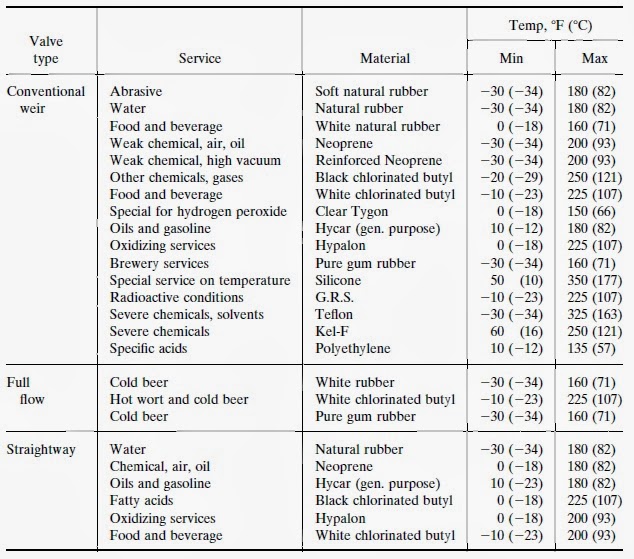Diaphragm Valve
Table of Contents
What is a Diaphragm Valve?
A diaphragm valve is a bi-directional, on-off throttle valve that contains a flexible and pressure-sensitive membrane known as a diaphragm [1]. The diaphragm is connected to a compressor that pushes it into contact with the bottom of the valve body or a seat to close the valve. The diaphragm valve can be used as an on/off valve, or even to control the flow of media. The two most common types of diaphragm valves are the Weir type and the straight through type [2].
Straight Through Type Diaphragm Valve Cross Section [2] | Weir Type Diaphragm Valve Cross Section [2] |
|---|---|
|
Advantages:
- The mechanism can be separate from fluid flow [3].
- Resistant to leaks.
- Can be used to throttle flow.
- Suitable for use with corrosive fluids, fibrous slurries, radioactive fluids, as well as fluids that must remain contaminant free.
Disadvantages:
- Moderate temperature/pressure (depends on the diaphragm material). Typically, they are used under 200 psi (14 bar) pressure and 204ºC [3].
- Complete discharge of the valve/pipeline is difficult due to the design.
- Diaphragm may experience erosion when extensively used in throttling situations containing impurities [4].
Applications:
Due to separation between the mechanism of the valve from the flow of material, the diaphragm valve is used where contaminants such as lubricant for the valve mechanism cannot be allowed into the fluid itself. Its resistance to leakage means it is used when material leakage could be disastrous [2].
Some common applications of diaphragm valves are:
- Water treatment facilities
- Pharmaceutical manufacturing
- Food/Chemical processing plants
- Breweries
- Corrosive applications [1]
- Waste management in nuclear facilities [3]
Specifications
Diaphragm valves lack industry standards, so the following section contains some parameters to help select the correct valve for different applications [1].
Valve Size
Knowing the flow rate through the valve, as well as the viscosity, specific gravity, etc. are important for determining the size of the valve necessary for each application. The pressures and temperatures that the valve will be subjected to are also needed when determining the range of forces that the valve will need to withstand. This information can then be cross-referenced in a table to get the desired ratio of inner to outer diameter for the valve [2].
Pressure Drop / Range
Make sure that the pressure drop across the valve is suitable for the application, as well as the valve chosen can handle the entire range of operating pressures that it will experience during operation [2].
Type of Valve + Actuator, Material
Determine the material of various sections of the valve that best fits the use and the material that the valve will be in contact with.
The material of the diaphragm is an important part of the valve. To the right is a table showing different types of diaphragm materials versus their operating temperature ranges, as well as what they are commonly used for in industry.
Consideration also needs to be given to the valve body's material. For example, stainless steel, bronzes, or other materials resistant to corrosion need to be used when dealing with corrosive media [1].
Another important aspect is whether the valve is a "wetted valve" or "non-wetted valve". In short, a wetted valve exposes the body and stem of the valve to the media, while a non-wetted keeps them separate. A benefit of the non-wetted valves is that the body can be made of non-corrosive resistant materials [2].
Lastly, the decision of type of actuation. This should be chosen based on force of the flow, and the valves location and use in the larger system. Common types of actuation include: manual, motor driven, pneumatic, thermal, hydraulic, etc. [1].
Types of Materials [3] |
|---|
Connection Type and Features
The connection between the valve and the rest of the system is also important. The valve could simply be screwed in via threads, welded together, sealed using flanges, or various other methods depending on application.
Lastly, features such as instrumentation, safety measures, and indicators of flow direction is beneficial, again, depending on application [1].
Suppliers:
Some suppliers of diaphragm valves are listed below:
Contributors:
| User | Last Update |
|---|
Faculty Advisor: Rachel Malevich (alumni)


